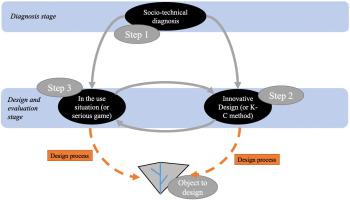Agricultural Systems ( IF 6.1 ) Pub Date : 2021-12-01 , DOI: 10.1016/j.agsy.2021.103337 Pauline Della Rossa 1, 2, 3 , Charles Mottes 1, 2, 4 , Philippe Cattan 5, 6 , Marianne Le Bail 3

|
CONTEXT
Chronic environmental pollutions are one of the most striking examples of negative externalities of intensive agriculture. To address this issue, an agroecological transition is necessary, requiring new design methods: While most design methods are suited to the field or farm scale, some innovations require an approach at the scale of the territory.
OBJECTIVE
In this article, we propose a new method to design an agricultural territory aiming to overcome an environmental pollution issue, i.e. to identify one or more combinations of agricultural practices, implemented by the farmers of the territory that reduce water pollution.
METHODS
We implemented the new method following three steps: first, we used a sociotechnical diagnosis to identify cognitive biases that prevent the actors from innovating in a disruptive way. Second, we used the K C method (based on C
C method (based on C K theory) to allow actors to innovate in a disruptive way. Third, we used a serious game to continue the design of the innovations and to test and assess them in a safe place. We implemented this new method in the Galion River watershed in Martinique (French West Indies) whose river is polluted by herbicides.
K theory) to allow actors to innovate in a disruptive way. Third, we used a serious game to continue the design of the innovations and to test and assess them in a safe place. We implemented this new method in the Galion River watershed in Martinique (French West Indies) whose river is polluted by herbicides.
RESULTS AND CONCLUSION
Using the method, actors have overcome existing path dependencies. Based on this, the method made it possible to design different innovations across scales in a participative way and with a systemic territorial point of view. Here, actors designed 15 innovations that enhance either the territory or the pooling of its resources. Among these, there was the sharing of the service of an itinerant breeder or the implementation of an ecotouristic circuit. Actors combined innovations across scales into three scenarios that created a new agricultural territory with fewer agricultural herbicides in the river.
SIGNIFICANCE
We suggest adding two participatory steps to improve the level of genericity of the method: a first step to discuss the initial question and the general organisation of the participatory process, followed by a second step dealing with how to insert the designed innovations in the serious game. Finally, we recommend this method in other territories requiring collective practice changes.
中文翻译:

在领土范围内共同设计农业系统的新方法 - 在马提尼克减少除草剂污染的应用
语境
慢性环境污染是集约化农业负外部性最显着的例子之一。为了解决这个问题,农业生态转型是必要的,需要新的设计方法:虽然大多数设计方法适用于田间或农场规模,但一些创新需要在领土范围内的方法。
客观的
在本文中,我们提出了一种旨在克服环境污染问题的农业领土设计新方法,即确定该领土农民实施的一种或多种农业实践组合,以减少水污染。
方法
我们通过三个步骤实施了新方法:首先,我们使用社会技术诊断来识别阻止参与者以破坏性方式进行创新的认知偏差。其次,我们使用 K  C 方法(基于 C
C 方法(基于 C  K 理论)让参与者以颠覆性的方式进行创新。第三,我们使用严肃的游戏来继续创新设计,并在安全的地方对其进行测试和评估。我们在马提尼克岛(法属西印度群岛)的加利翁河流域实施了这种新方法,该流域的河流受到除草剂的污染。
K 理论)让参与者以颠覆性的方式进行创新。第三,我们使用严肃的游戏来继续创新设计,并在安全的地方对其进行测试和评估。我们在马提尼克岛(法属西印度群岛)的加利翁河流域实施了这种新方法,该流域的河流受到除草剂的污染。
结果与结论
使用该方法,参与者克服了现有的路径依赖性。在此基础上,该方法使得以参与方式和系统的地域观点设计跨尺度的不同创新成为可能。在这里,参与者设计了 15 项创新,以增强领土或整合其资源。其中包括共享流动饲养员的服务或实施生态旅游线路。参与者将跨尺度的创新组合成三个场景,创造了一个新的农业领域,河流中的农业除草剂更少。
意义
我们建议添加两个参与步骤以提高方法的通用性水平:第一步讨论初始问题和参与过程的一般组织,然后第二步处理如何将设计的创新插入严肃游戏. 最后,我们在其他需要集体实践改变的地区推荐这种方法。










































 京公网安备 11010802027423号
京公网安备 11010802027423号